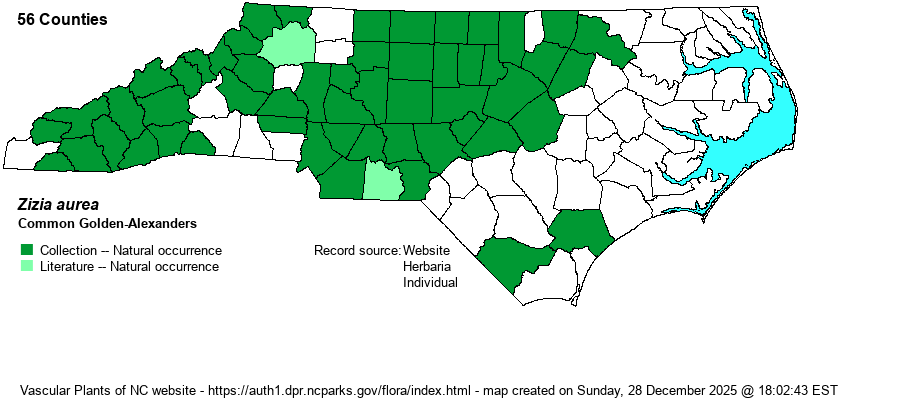| Author | (L.) W.D.J. Koch | |
| Distribution | Throughout the mountains and most of the Piedmont; a few southern Coastal Plain records.
This is a widespread Eastern species, ranging from eastern Canada south to northern FL and eastern TX. It is scarce in parts of the Coastal Plains.
| |
| Abundance | Fairly common to frequent in the Mountains and the Piedmont, though oddly scarce in the western Piedmont. Very rare in the southern Coastal Plain. | |
| Habitat | This species has quite a broad range of habitats, often in circumneutral soil. It can often be found along stream margins, especially where scoured, or in bottomland openings. However, it is the most frequently seen Zizia or Thaspium in mafic glades and barrens, powerline clearings, and various meadows. It seldom is seen on rich forested slopes, unlike some others in these genera. | |
| Phenology | Blooms in April and May, and fruits in June and July. | |
| Identification | This is a medium-sized herb, growing to 1.5-2 feet tall, with several branches in the upper portions. It has basal and stem leaves similar, usually twice-pinnately divided, with the leaflet segments lanceolate to ovate. Each leaflet is about 1.5-2 inches long and half as wide, but in this species the marginal teeth are very fine, 5-10 teeth per centimeter of margin. At a distance, the leaves/leaflets look entire, as all others with pinnately divided leaves have more obvious and stronger teeth, and many fewer as well. Otherwise, it has a similar inflorescence as others, with several umbels with bright yellow flowers. Separate this species not by its umbels but by the fineness and evenness of the many very small teeth; the leaves are thick and rather shiny, as well. Zizia trifoliata and Thaspium barbinode have much larger and many fewer teeth along the leaflet margins. | |
| Taxonomic Comments | None
| |
| Other Common Name(s) | Golden Zizia | |
| State Rank | S4S5 [S5] | |
| Global Rank | G5 | |
| State Status | | |
| US Status | | |
| USACE-agcp | FAC link |
| USACE-emp | FAC link |

